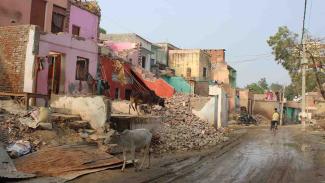Ayodhya is experiencing an intense land acquisition spree for the last couple of years following the Supreme verdict in 2019 in spite of people's oppositions and protests along with a visible stock market boom in shares of companies who have invested in real estate, hotels, tourism etc in Ayodhya. These stocks have swung up by 20% to more than 50% much above the average stocks' tally. The ongoing large-scale, apparently mutual, corporate purchase of lands is taking place after forcing farmers under distress that they are left with no better option than to sell their meagre possession to the sole bidder. This is tacitly encouraged by administrative understanding in favour of big land grabbers.
The government has acquisitioned lands with, or even without, a meagre compensation amount for many of the projects under Ayodhya Master Plan that includes an airport and building/widening of roads. This accompanies large scale displacement and repeated violations of court orders regarding proper compensation and rehabilitation of evictees. The Allahabad High Court had instructed the UP government in 2020 to follow the due procedure as per the Land Acquisition, Rehabilitation and Resettlement Act of 2013. The Land Conflict Watch claims 4000 homes and shops demolished by 2023 affecting 40000 people. The compensation given to some but was highly inadequate. Many small shopkeepers got only Rs. one lakh for their decades old rented shops and now they are told to buy new shops at distant locations for Rs. 30 lakhs which they are unable to pay.
In the countryside private real estate agents are exploiting the fear of farmers of land acquisition by the government at much cheaper rates and offering them somewhat higher prices which are much below the prevailing market sentiment.
The Ayodhya redevelopment project costing rupees 28000 crores undermines the concerns of citizens of Ayodhya. This is expressed in Ayodhya traders' union leader Nandu Gupta’s worries that this kind of development is bound to displace a large number of locals whose interest and welfare should have been given a centre stage.
The local population at lower rungs of the economic spectrum who earlier saw better economic opportunities in the development of Ayodhya town are now apprehensive and hopeless. The Ayodhya pilgrimage was a major means of livelihood for most of its residents who in turn provided affordable services to pilgrims. The planned entry of big capital is bound to change this scenario by excluding the locals from the developmental matrix and making Ayodhya tourism costlier for its visitors.











